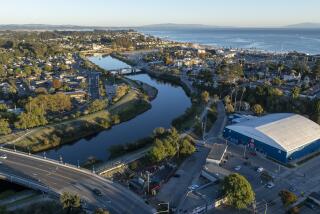Campus Housing Taking Shape at New University
It’s beginning to look like a community around Cal State Channel Islands.
Construction crews are building the first phase of a housing project at the soon-to-open university. The mix of apartments, townhouses and single-family homes will serve as the cornerstone of a mini-city on the eastern edge of the Camarillo campus.
Workers have installed curbs, gutters and lighted walkways along sycamore-lined streets slicing through the development in a canyon in the shadow of the Santa Monica Mountains.
They have graded the earth and set the forms to pour the foundations for 207 units, which are being built on a slope that rises above the campus and provides spectacular views of the Channel Islands.
The first of those units is scheduled to be completed by the university’s Aug. 26 opening.
Four more phases will follow over the next five years, eventually providing 900 housing units as part of a self-contained community designed to sustain the college campus and the people who will work and go to school there. “They’re moving pretty fast,” said George Dutra, a university vice president in charge of development, as he stood at the center of what will be Elephant Seal Cove Drive.
“I can’t think of a prettier place, quite frankly,” he said. “Two years ago, you would have never known all this was possible.”
In June 2000, the CSU Channel Islands Site Authority approved a master plan to guide creation of a range of income-generating ventures designed to help expand the campus over the next 25 years.
At the heart of those efforts was a community of 900 houses, with a town square, bike and pedestrian paths, a child-care center and an elementary school.
The projects are designed to generate the millions of dollars needed to create academic space for as many as 15,000 students eventually expected to attend Cal State Channel Islands.
And the housing component, where units will be offered at below-market rates to faculty and staff, was seen as especially critical in the university’s efforts to lure top employees to the budding campus.
In the first phase of the University Glen housing project, the college plans to offer 36 single-family homes, which will range from 1,689 square feet to 2,282 square feet, for $224,000 to $299,000. The sales price of a typical Ventura County home is $304,000.
The university also is building 100 apartments in the first phase and 71 townhouses, which will be for sale and for rent. The townhouses will range from 1,300 square feet to 1,800 square feet and will sell for $166,000 to $231,000.
Several financing packages--including low-interest loans and 100% mortgages--are being put together to help faculty and staff buy into the project.
Channel Islands economics professor Dennis Muraoka, who is chairman of the Academic Senate, said there is much interest in the housing among the university’s 13 founding faculty members.
But he said he hopes the housing project also gives the university an edge in recruitment, noting that founding faculty members are scrambling to fill 25 teaching positions.
“I think it is something we are definitely going to talk about in our recruitment,” Muraoka said. “It’s going to make [working at Channel Islands] very attractive.”
The first phase isn’t done yet, and Dutra already is looking ahead.
Bumping along in a four-wheel drive on the muddy, half-formed roads where future phases will unfold, he talked of plans for creation of a Chumash demonstration village and a public elementary school that will serve as a training ground for college students pursuing education careers.
And he talked of creating a commercial center complete with restaurants, bookstores and other businesses.
“It’s a unique project,” he said. “And I feel good about it. It’s part of the overall success of this university.”
More to Read
Sign up for Essential California
The most important California stories and recommendations in your inbox every morning.
You may occasionally receive promotional content from the Los Angeles Times.






